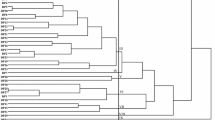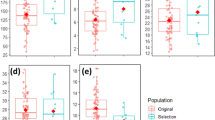Summary
Selection criteria of dura female parents and pisifera male parents were investigated by employing a step-wise multiple regression procedure. Independent parental variables entered in the regression equation were (1) yield (Y) and (2) bunch index (BI), i.e. the proportion of total dry matter used for fruit bunches, of the female parents. As secondary characters of both parents were included: (3) leaf-Mg level (LMG), (4) leaf area ratio (LAR), i.e. the ratio of new leaf area produced to new dry matter used for vegetative growth, and (5) sex ratio (SR), i.e. the ratio of female to total inflorescences. The joint contribution of LMG in both parents accounted for 80% of the variance in Y of the offspring. The amount of the total variance in BI of the offspring was substantially explained, in decreasing order, by LMG of the pisifera parents, and Y and LAR of the dura parents. The first two variables explained 70% of the variation in offspring BI. SR and BI appeared to be not significant for explaining Y as well as BI of the offspring. A practical implication is that for pisifera testing programs, pisifera can be efficiently screened on the exclusive basis of LMG. Dura tester parents should be selected for high, and little variable, values of LMG, Y and LAR.
Similar content being viewed by others
References
Breure, C. J., 1978. Research report Dami Oil Palm Research Station 1971–1977, Volume I and II, 215 pp.
Breure, C. J., 1982. Factors affecting yield and growth of oil palm tenera in West New Britain. Oléagineux 37: 213–228.
Breure, C. J., 1985. Relevant factors associated with crown expansion in oil palm (Elaeis guineensis Jacq.). Euphytica 34: 161–175.
Breure, C. J., J., Konimor & E. A. R., Rosenquist, 1982. Oil palm selection and seed production at Dami Oil Palm Research Station. Oil Palm News 26: 6–22.
Breure, C. J. & R. H. V., Corley, 1983. Selection of oil palm for high density planting. Euphytica 32: 177–186.
Comstock, R. E. & H., Robinson, 1952. Estimation of the average degree of dominance of genes. In: J. W., Gowan (Ed.), Heterosis. Ames, Iowa State College Press.
Corley, R. H. V., J. J., Hardon & G. Y., Tan, 1971. Analysis of growth of the oil palm (Elaeis guineensis Jacq.). Estimation of growth parameters and application in breeding. Euphytica 20: 307–315.
Falconer, D. S., 1961. Introduction to quantitative genetics. London, Oliver and Boyd. 365 pp.
Gray, B. S., 1969. The requirements for assisted pollination in oil palms in Malaysia. In: P. D., Turner (Ed.), Progress in oil palm. Kuala Lumpur, Incorporated Society of Planters. p. 49–66.
Hardon, J. J., C. N., Williams & I., Watson, 1969. Leaf area and yield in the oil palm in Malaysia. Expl. Agric. 5: 25–52.
Hardon, J. J., R. H. V., Corley & S. C., Ooi, 1972. Analysis of growth in the oil palm. II. Estimation of genetic variances of growth parameters and yield of fruit bunches. Euphytica 21: 257–264.
Hardon, J. J., R. H. V. Corley & C. W. Lee, 1982. Breeding and selection for vegetative propagation in the oil palm. Proceeding of the VIII Long Ashton Symposium on ‘Improvement of vegetatively propagated plants’.
Kim, J. O. & F. J., Kohout, 1975. Multiple regression analysis: subprogram regression. In: N. H., Nie, C. H., Hull, J. G., Jenkins, K., Steinbrenner & D. H., Bent (Eds), SPSS: Statistical Package for the Social Sciences (second edition). New York, McGraw-Hill Book Company, p. 320–367.
Ollagnier, M., 1983. Personal communication. Institute de Recherches pour les Huiles et Oléagineux, Paris, France.
Powell, M. S., 1984. Personal communication. Dami Oil Palm Research Station. Kimbe, West New Britain, Papua New Guinea.
Rajacopalan, K., F. B., Aderungboye, C. D., Obasola & A., Eme, 1978. Evaluation of oil palm progenies for reaction to the vascular wilt disease. J. W. Afr. Inst. Oil Palm Res. 5(20): 87–95.
Renard, J. L., J. P., Gascon & A., Bachy, 1972. Research on vascular wilt disease of the oil palm. Oléagineux 27 (12): 581–591.
Sparnaaij, L. D., 1972. Report on a visit to the Nigerian Institute for Oil Palm Research. Limited circulation.
Spitters, C. J. T., 1985. Personal communication. Department of Theoretical Production Ecology, Agricultural University, Wageningen, The Netherlands.
Stam, P, 1984. Estimation of genotypic values without replication in field trials. Euphytica 33: 841–852.
Syed, R. A., 1982. Insect pollination of oil palm: Feasability of introducing Elaeidobius spp. into Malaysia. In: E., Pushparjah & Chew Poh, Soon (Eds), The Oil palm in agriculture in the eighties. Kuala Lumpur, Incorporated Society of Planters. p. 263–289.
Tan, G. Y. & J. A., Rajaratnam, 1978. Genetic variability of leaf nutrient concentration in oil palm. Crop Sci. 18: 548–550.
Author information
Authors and Affiliations
Rights and permissions
About this article
Cite this article
Breure, C.J. Parent selection for yield and bunch index in the oil palm in West New Britain. Euphytica 35, 65–72 (1986). https://doi.org/10.1007/BF00028542
Received:
Issue Date:
DOI: https://doi.org/10.1007/BF00028542




